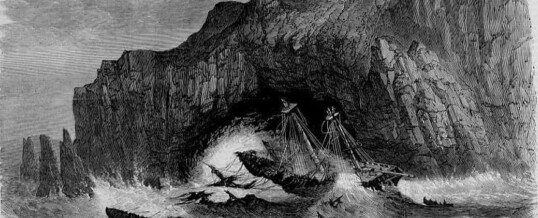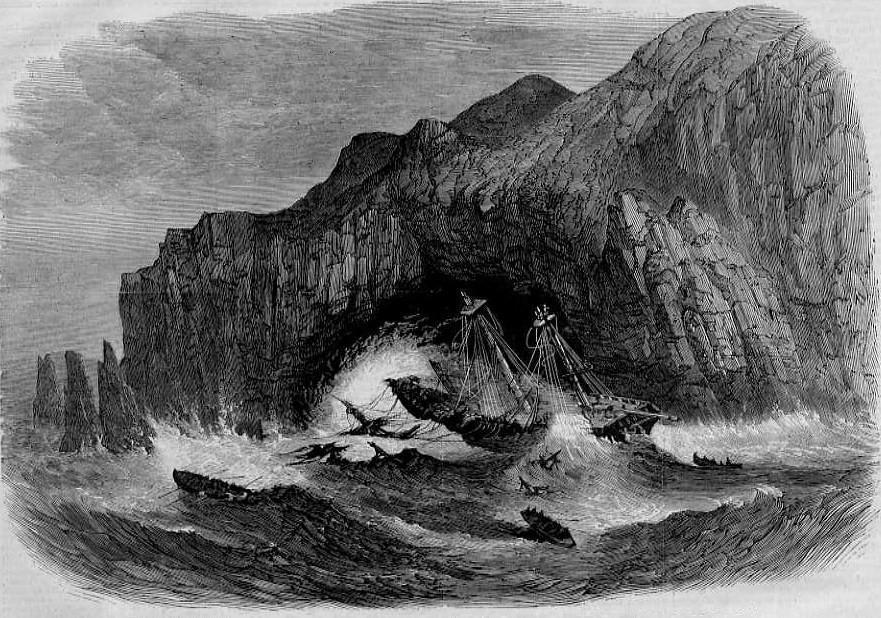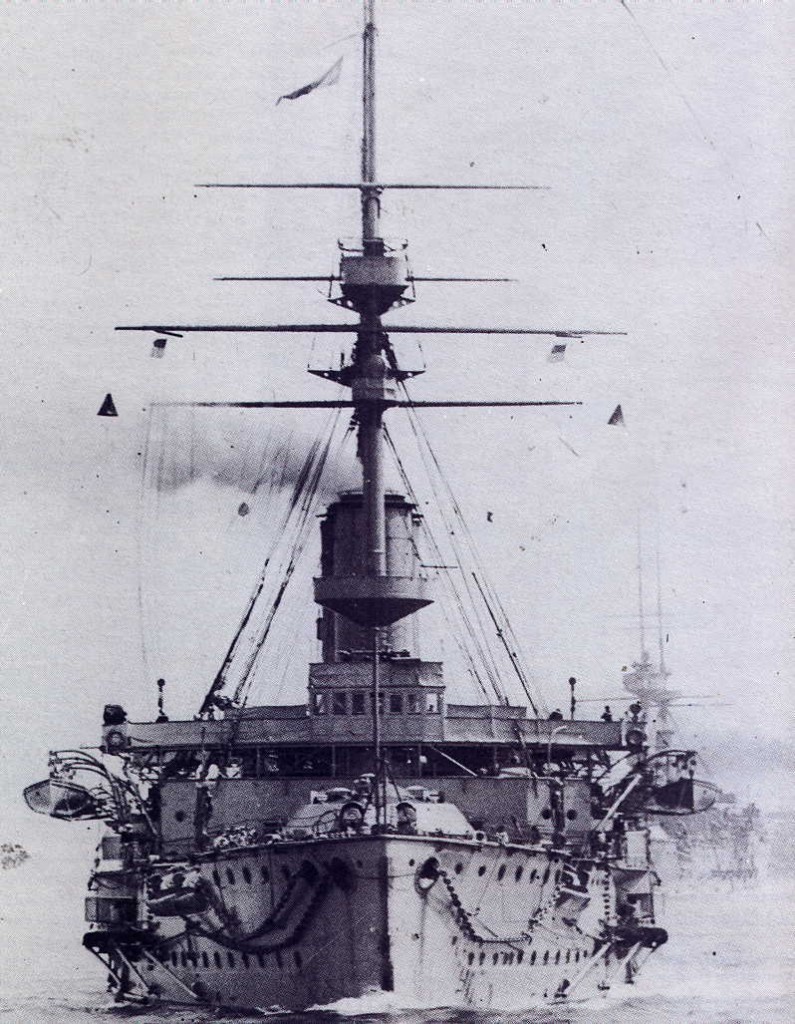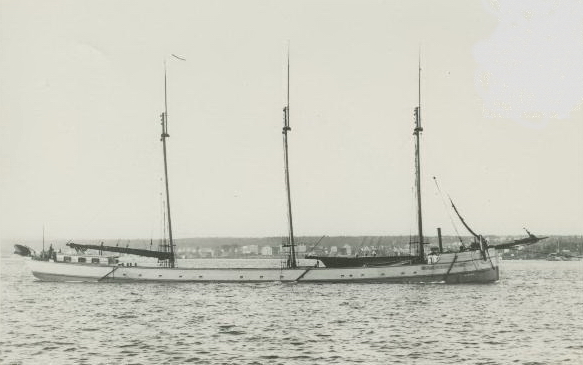
Following the loss of the convict Neva on May 13, 1835, over 200 women (most drunk on pillaged rum) and children perished. Despite her size and power, the British warship Goliath couldn’t handle the blow she took on May 13, 1913, and went down. The question for today is: How did a ship come to be wrecked in a cave and much gold was really on the bark General Grant? If you are reading this in a post, go to http://shipwrecks.com/shipwrecks-of-may-13/ to learn more about these shipwrecks and some of the many others that have occurred on this day over the centuries.
Today’s Shipwrecks™
May 13
compiled and edited by Dr. E. Lee Spence
1793: The American schooner Three Brothers, Captain Cameroy, bound from the Cape to North Carolina, was wrecked on May 13, 1793, on Molasses Reef in the Turks & Caicos Islands.
1796: The HMS Salisbury, a 27 year old, two decked ship of 50 guns, Captain Wilson, was wrecked on May 13, 1796, “on a reef near Isle de Vache, off the coast of Hispaniola. *** When the boat left the Salisbury she was filling fast but the crew were all safe and were eventually taken up by a schooner, Lt. Man, dispatched from Port Royal, to render assistance.”
1802: The schooner Mary, Captain Woodward, was upset in Charleston Harbor, South Carolina, opposite Fort Johnson during a squall on May 13, 1802, while the captain was at the fort making the customary report as required by law. The Mary was from Savannah and carried a cargo of tobacco, sugar and cotton consigned to Muir and Company.
1802: The British ship Triton, bound from Boston, Massachusetts, to Plymouth, England, foundered in the Atlantic Ocean 30 nautical miles west of the Isles of Scilly with the loss of six of her nine crew.
1819: The schooner Phoenix, Captain Coffin, bound from Suffolk to Philadelphia, wrecked on Cape Hatteras, North Carolina, on May 13, 1819.
1835: The three masted bark Neva, which was being used to carry convicts to Australia, was wrecked on May 13, 1835. Neva had sailed from Cork, Ireland for Sydney, Australia, on January 8, 1835 carrying 150 female convicts with 33 children, and nine free women (who were probably wives of convicts) with 22 children, all under the care of Surgeon Superintendent John Stephenson, Royal Navy, and 26 crew under the command of Captain Benjamin Peck. With the deaths of a crewman, a convict and a free woman, and one birth, during the voyage, by the time she reached the Australian coastline Neva‘s total complement was 239.
About 5 a.m. on May 13, 1835 the Neva hit a reef northwest of King Island in the Bass Strait, which separates Tasmania from the state of Victoria on the Australian mainland, and broke up rapidly. Many of the women became hopelessly drunk on rum that was being carried as cargo and were unable to save themselves. Twenty-two survivors drifted ashore on the northern end of King Island on two rafts formed by the fore and aft decks of the collapsed ship, but seven of these died of exposure “aided if not abetted by the inordinate use of rum” during their first night ashore. The remaining fifteen survivors, including the captain and the chief officer, lived with local sealer John Scott and his aboriginal wives and children until a fortnight later when the schooner Sarah Ann rescued and carried them to Launceston.
Initial news reports state that Neva was wrecked on the Navarine Reefs, which lie northeast of Cape Wickham on King Island. An inquiry into the loss of the ship exonerated Captain Peck from any blame and attempted to demonstrate that the Navarine Reefs were not the location of the disaster. A map by the master suggests that the vessel hit an uncharted reef well to the west of King Island, but modern reconstructions suggest Neva hit the Harbinger Reefs, because the captain had failed to allow for the set of the currents at the northern end of the island after land was first seen.
A memorial plague is dedicated to the Neva at the Tasmanian Seafarers’ Memorial at Triabunna on the east coast of Tasmania, contains the following text:
Neva
Convict Transport Barque of 327 tons
sailed from Cork, Ireland on 8.1.1835.
Captain Peck with 26 officers and crew,
150 female convicts with 33 children,
9 free women and 22 children bound for
Sydney. 13.5.1835 struck Harbinger Reef
north of King Island with 239 aboard.
22 made landfall where 7 later died.
~ Tasmania’s second worst shipwreck. ~
1836: On May 13, 1836, the British vessel Santa Maria, bound from Liverpool, England to Maranhão, was driven ashore at Maranhão in northeastern Brazil.
1859: A ship was seen on shore to the northeast of Riding Rock, Bahamas on May 13, 1859, by the Armorial, which was bound from Liverpool to Havana.
1866: The American bark General Grant while bound from Melbourne for London, with a cargo of wool, skins, and 2,576 ounces of gold, collided against the cliffs of Auckland Island and drifted into a large cave on the island’s western shore on May 13, 1866. The rising tide and increasing swell caused her main mast to repeatedly strike the cave’s roof until the mast was forced through the bottom of her hull and the she sank. She was carrying 58 passengers and 25 crew. Fifteen people survived the actual wreck but this was a subantarctic island and there were no people to help them. By the time they were rescued on November 27, 1867 only 10 were left.
Besides the gold the General Grant carried as cargo, a number of successful miners from the Australian gold fields were among her passengers and they were known to have had considerable gold with them too. There was even speculation that her 9 tons of ballast, listed on the manifest as zinc spelter, was really gold.
The General Grant was a wooden, three-masted bark built in Maine in 1864. She was registered in Boston and was owned by Messers Boyes, Richardson & Company. She was 1,005-tons, and measured 179.5 feet in length, 34.5 feet in breadth and 21.5 feet in depth of hull.
This was the third time in just three years that ships had been lost in the Aucklands, with survivors who went through long, terrible ordeals before being rescued. The other two being the Grafton in 1864 and the Invercauld in 1865. As a result, the New Zealand government established a network of castaway depots and regular visits by government vessels to the islands.
The General Grant‘s cargo of gold has attracted numerous salvage expeditions, several of which have proved deadly, but none have been successful in even finding the wreck.
1884: The Harriet Lane foundered in the Caribbean Sea on May 13, 1884.
1915: The British battleship HMS Goliath, Captain Thomas Lawrie Shelford, was torpedoed and sunk by the Turkish torpedo boat Muavenet-i Milliye in the Dardanelles with the loss of 570 of her 700 crew.
On the night of May 12–13, Goliath was anchored in Morto Bay off Cape Helles, along with HMS Cornwallis and a screen of five destroyers, in foggy conditions. Around 1:00 a.m. on 13 May, the Turkish torpedo boat destroyer Muavenet-i Milliye, which was manned by German and Turkish crew, eluded the British destroyers Beagle and Bulldog and zeroed in on the battleships. Muavenet-i Milliye fired two torpedoes both of which struck Goliath almost simultaneously. One struck by her forward turret and the other near her forward funnel, immediately causing a massive explosion. Goliath began to capsize, and was already on her side when a third torpedo struck near her after turret. She then roll upside down and sank bow first. Five hundred and seventy of her 700 man crew died, including her commanding officer.
Despite being spotted and fired on as soon as her first torpedo hit the Goliath, the Muavenet-i Milliye managed to escaped untouched. Her captain Ahmet Saffet Bey was afterwards hailed as a hero by his side and promoted to the rank of major, while his German co-commander, Rudolph Firle, received the Iron Cross 1st Class as well as Austro-Hungarian and Turkish medals.
1916: On May 13, 1916, the British cargo ship Eretria struck a mine and sank in the Bay of Biscay 15 nautical miles south south west of the Île d’Yeu, France.
1917: The British cargo ship Jessmore was torpedoed and sunk in the Atlantic Ocean 180 nautical miles west north west of the Fastnet Rock by Imperial German submarine SM U-48. Her crew survived.
1917: The Italian sailing vessel L’Independiente F was scuttled in the Mediterranean Sea south of the Cabo de Gata, Spain, in latitude/longitude 36°31’N 2°02’W on May 13, 1917, by Imperial German submarine SM U-47.
1917: The Italian cargo ship Rio Amazonas was sunk in the Mediterranean Sea 150 nautical miles (280 km) south west of Crete, Greece, in latitude/longitude 33°40’N 20°46’E, by Imperial German submarine SM U-38. Her crew was saved.
1917: On May 13, 1917, the Norwegian barque Hudson was sunk in the Atlantic Ocean 30 nautical miles north north west of Ouessant, France, in latitude/longitude 48°48’N 7°56’W, by Imperial German submarine SM UC-17. Her crew survived.
1917: The Danish three-masted barque Anna was sunk on May 13, 1917, in the English Channel thirty nautical miles north east of the Île de Batz, France, in latitude/longitude 49°12’N 4°26’W, by Imperial German submarine SM UC-17. There was no loss of life.
1921: The barge Miztec was sunk in 1921, while being towed by the steamer Zillah, on the traditional day of bad luck, Friday the 13th, with the loss of all hands. She came to rest on Lake Superior’s bottom off Whitefish Point in the Upper Peninsula of Michigan. No bodies were recovered from the Miztec’s sinking site, but six days after she sank, the body of Mrs. Florence Pederson, the cook and the wife of the captain of the Miztec, was found on Maple Island, Ontario, Canada.
She was built as a 3-masted schooner in 1890, and was 194 feet in length, 34 feet 6 inches in breadth and 14 feet in depth of hold. The schooner was later stripped of her masts and running gear and converted to a barge to carry lumber and other bulk cargo. She was carrying salt when she was lost. The Miztec was an estimated $10,000 loss to O.W. Blodgett Lumber Company.The Miztec’s wreck was discovered in 1983 by the Oddessey Foundation in 45 to 50 feet of water at latitude/longitude 46°48.073’N 85°04.500’W. The Michigan Department of Natural Resources and Environment (DNRE) raided the Great Lakes Shipwreck Museum at Whitefish Point in 1992 for artifacts they claimed had been illegally removed from the Great Lakes bottomlands. The DNRE seized around 150 artifacts from the museum, including a triple-sheave block and hook and a double sheave block and hook from the Miztec. Following a settlement agreement between the Great Lakes Shipwreck Historical Society and the State of Michigan, the State’s artifacts from the Miztec are on permanent loan to the Great Lakes Shipwreck Historical Society for display in the Great Lakes Shipwreck Museum.
The Miztec’s wreck is now treated as an underwater museum and is part of the Whitefish Point Underwater Preserve. The Miztec’s remains are broken and scattered on the lake bottom but her anchor and chain and other gear are still present. Although the Miztec’s wreck is one of the shallower wrecks in the preserve, sports divers are cautioned to be certain of their abilities and equipment for dives because the preserve does not include protective bay or coves from the cold and volatile weather. Divers who visit the wreck sites are required to observe preservation laws and “take nothing but pictures and leave nothing but bubbles”.
1931: The American schooner J. O. Webster went ashore in Long Island Sound and was wrecked on May 13, 1931.
1942: The American cargo ship Norlantic, loaded with a 3,860 tons of general cargo that included cement and steel pipe, sailed from Pensacola, Florida, for Puerto La Cruz, Venezuela, in May of 1942. In the early morning hours of May 13, while about 90 nautical miles east of Bonaire, the vessel came under attack by German submarine U-69. At 03:38 hours, U-69, under the command of Kapitänleutnant Ulrich Graf, launched two torpedoes that missed the ship. After closing to a distance of 2,200 yards from Norlantic, Graf began shelling the vessel. After the first several shell hits on Norlantic, her crew tried to signal the German boat that they were abandoning ship to avoid further attack, and launched two lifeboats and two life rafts. Graf, unaware of the signal attempt, continued shelling the boat. At 04:11, three minutes after a coup de grâce hit Norlantic‘s port boiler room, the ship sank in 12°13’N 66°30’W, taking with her six dead — two who had died when the boiler room was hit, and four who had been killed by shellfire during the evacuation of the boat. A seventh man in one of the lifeboats later died of his wounds.On the afternoon of May 16, three days after the attack, the lifeboats were spotted by Netherlands trading schooners India and Mississippi, which took the boats under tow to Bonaire. Eight days later, and 11 days after the attack, two men aboard one of the rafts were rescued by SS Marpesia and landed at Port of Spain, Trinidad. The three men on the second raft were finally rescued on June 19 by the tug Crusader Kingston at position 14°2?N 83°13?W, having drifted some 1,000 nautical miles in the 37 days since the Norlantic’s sinking.
The Norlantic was a “design 1099 ship” with a displacement of 2,606 tons and a crew of 29.
• • •
NOTE: This is by no means meant to be a complete list of the vessels lost on May 13, as there have been thousands of ships lost for every day of the year. All of the above entries have been edited (shortened) and come from various editions of Spence’s List™. The original lists usually give additional data and sources. Those lists are being updated and are or will be made available for a fee elsewhere on this site.
Click here to check out Dr. E. Lee Spence’s Facebook page on shipwrecks and treasure.
© 2013, 2017 by Dr. E. Lee Spence for composition, content and compilation.
Share


what ever happened to the 1849 veronica, did it ship wreck?
Gilbert,
According to the London Morning Chronicle, of the 18th of April, 1849, “The Veronica, in attempting to go out today, missed stays, and went on shore upon the Annet, but is expected to be got off next tide; crew saved.”
The 1848-49 edition of Lloyd’s Register of British and Foreign Shipping, shows the snow Veronica, Captain Baker, 249 tons, as built at Sunderland in 1840. She was owned by B. Walker, and her home port was Scarborough, England. She was iron bolted.
Note One by ELS: The Annet [aka the Annet Sand] is a bank, which stretches out a mile from the N.E. point of the North Esk River at Montrose harbor, Angus, Scotland, into the sea.
Note Two by ELS: Most of the time when you see a report that states “crew saved,” it is a fairly safe bet that the vessel was lost, as her only real hope after her crew has been “saved,” i.e. taken off the wreck, is that the vessel will hold together long enough that she can be pulled off by a salvors, and even then, without a full crew on board to handle her, she could still be lost. The Veronica is listed in the 1848-49 edition of Lloyd’s Register, but not in the 1849-1850 edition, which is another very good indication that she was lost.
I hope this helps. Best wishes,
Lee